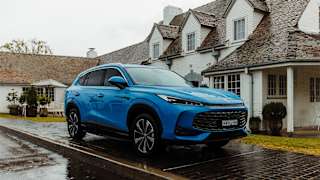As mentioned above, the HR-V is a pragmatist’s car. If you’re the sort of person who digs the idea of a tiny house, you’re going to love the HR-V.
That’s because it packages a lot of smarts into its little body. I’m referring to, mainly, the 60:40 rear Magic Seats. They are almost like witchcraft, allowing you to lift up the seat bases in that split or altogether, while the seat backrests can also be lowered completely flat, allowing a massive storage space if you have longer items to cart with you.
I’m talking about 1462 litres (VDA) when the rear seats are folded down, or a still excellent-for-the-class 437L (VDA) with the rear seats in the upright, most reclined position. That figure is to the parcel shelf level, though the standard cargo cover is actually a folding mesh divider. You can option an accessory hard tonneau cover for the cargo area if you need it.
The boot easily fit all three CarsGuide suitcases (124L, 95L and 36L) with the seats in place, and there was actually room to spare. Speaking of spare, under the boot floor is a space saver spare wheel.
Really, the HR-V’s boot and back seat is why you buy this car. It’s superbly practical and really spacious as well. In the back row, with the driver’s seat set for my position (I’m 182cm or 6’0”), I had enough space to sit for hours. There’s ample knee room, toe room and shoulder space, and while headroom is good those who are taller will need to watch their head getting in or out of the car, as the roofline rakes down quite a bit.
Rear amenities comprise dual map pockets and there are door pockets which are a weird shape, making it hard to fit a bottle in. There is no centre armrest or cup holders, but there’s a bottle holder in front of the middle rear seat, which is also where you’ll find a 12-volt outlet - but sadly, no USB ports, as many competitors now offer.
The materials are really nice, with soft finishes on the doors and padded elbow sections - all of which make the rear seat of the HR-V feel a bit more special than most rivals.
Up front the design of the dash has stood the test of time okay, though even with the new media screen it isn’t as modern as many rivals. The screen itself is positioned at a bit of a strange angle, which meant that driving at night saw a reflection on the windscreen up near the rearview mirror.
The screen itself isn’t the best quality, either. There’s a weird fuzziness to the display, and it’s not as high resolution as, say, a VW T-Cross’s screen. It looks a bit blurry, as you might be able to see from the images.
The menus on-screen are reasonably easy to learn, but annoyingly there is no volume knob for quick adjustments. Further, you can’t change the audio settings (bass, treble, EQ etc) when you have a smartphone connected via USB. It has to be done when you’re not plugged in, which means you might set the wrong parameters for what you end up listening to.
That’s annoying. And you know what else was annoying? That our test car's screen didn't flick in to Android Auto mode when we connected an Android phone. We tried multiple times, yet couldn't get it to work.
So while the addition of the new screen does bring the HR-V up to date in terms of phone mirroring tech, you could actually probably do better by choosing an aftermarket head unit and having it installed. If you bought a pre-owned HR-V and did that, you’d save some big cash, too.
Otherwise the cabin is pretty good up front, with door pockets suitable for bottle holders, central multilevel cup holders (that can be turned into bottle holders if you need), plus a small covered centre console bin. There’s no space in front of the gear selector for your phone or wallet, but there’s a shelf below the selector - which is a bit out of sight and out of mind - that would be suitable for a handbag.
That’s also where the USB ports are - one for the screen (thankfully, because the old screen had a USB port that made for a messy cable situation), the other for recharging devices. There’s a 12-volt outlet there too.
The pixelated monochrome digital driver’s display doesn’t have a digital speedo, and it’s just another element that dates the cabin of the HR-V. But if you can overlook those little things, it’s a very practical car.




















































 copy.png)




.png)








